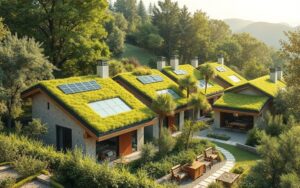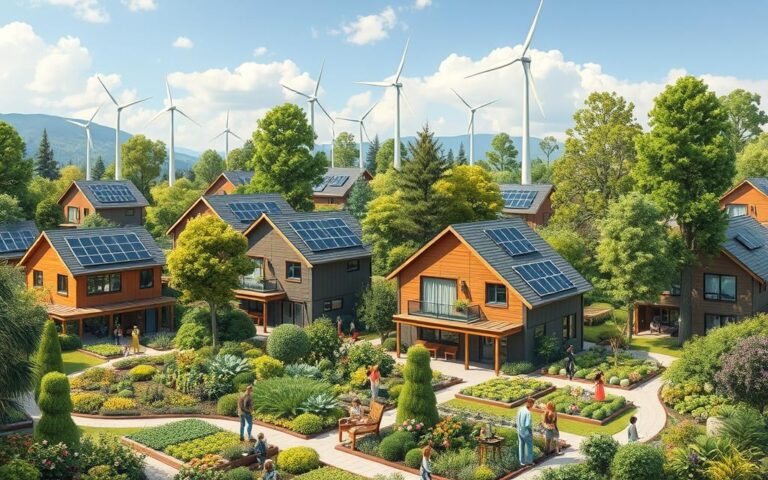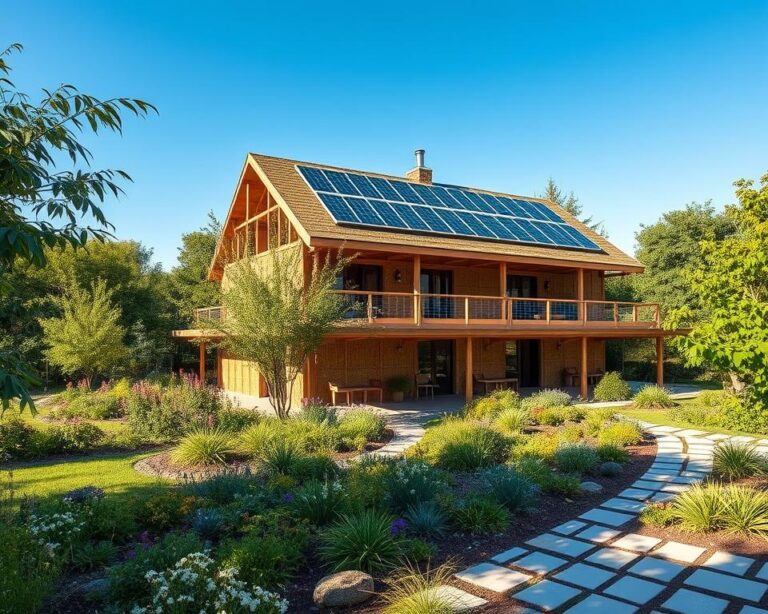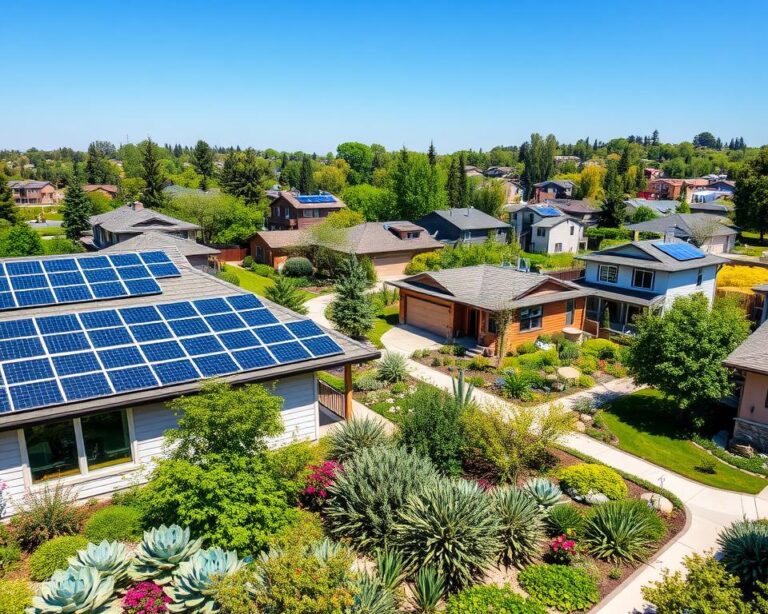Did you know buildings use nearly 40% of global energy and cause a lot of carbon emissions? It’s clear we need sustainable housing ideas for our planet’s future. With climate change, eco-friendly designs and green building are more urgent than ever.
This article will look at ten new ideas in sustainable housing. These ideas focus on energy-saving homes, less environmental harm, and better health. We’ll see how passive solar design and using recycled materials can lead to a greener future.

Introduction to Sustainable Housing Concepts
Sustainable housing focuses on living spaces that blend with nature. It uses environmentally friendly designs to improve efficiency and well-being. The push for green building has grown as people want to cut down on carbon emissions.
Building practices have changed due to environmental concerns. Issues like climate change and resource use are driving the need for new housing ideas. Today’s homes use renewable energy, better insulation, and eco-friendly materials. This meets today’s needs while protecting nature.
New trends like smart tech and biophilic design are changing homes. These ideas make homes look better and healthier. As we build more, using sustainable ideas is key to a greener future.
The Benefits of Sustainable Housing
Sustainable housing offers many benefits for our planet and our communities. These benefits of sustainable housing cover the environment, economy, and social aspects. They help us live greener and healthier lives.
Environmental Impact
Sustainable homes have a big positive effect on the environment. They use less energy and materials that are good for the planet. This helps fight climate change and saves our natural resources.
These homes also collect rainwater and use solar panels. This makes them even better for the environment.
Economic Advantages
Sustainable housing saves money and increases property value. It costs less to run and can sell for more. Homebuyers want homes that are good for the planet.
Homeowners also get tax breaks and grants for green upgrades. This makes sustainable housing a smart investment.
Social Benefits
Sustainable housing brings people together. It creates a sense of community and well-being. Green neighborhoods have parks and spaces for people to meet and play.
| Benefit Type | Description |
|---|---|
| Environmental Impact | Reduces greenhouse gas emissions and conserves resources. |
| Economic Advantages | Lower utility bills and increased property values. |
| Social Benefits | Enhances community well-being and quality of life. |
Passive Solar Design
Passive solar design is a smart way to use the sun’s energy for heating and cooling. It helps make homes use less energy. This means lower bills and a greener home.
What is Passive Solar Design?
Passive solar design means placing buildings to catch the most sunlight. It cuts down on the need for heating and cooling systems. This makes homes cozy all year.
Designers use sunlight in their buildings. They plan carefully and use special elements.
Key Features of Passive Solar Homes
Passive solar homes have key features that make them special:
- Strategic Window Placement: Windows face the sun to let in lots of light and warmth.
- Thermal Mass Materials: Stuff like concrete and brick soak up heat and keep it inside.
- Natural Ventilation: Good design lets cool air in, so you don’t need air conditioning.
These features make homes work well and are good for the planet. Using passive solar design saves energy and money over time.
| Feature | Description | Benefits |
|---|---|---|
| Strategic Window Placement | Maximizes natural light and heat gain. | Reduces reliance on artificial lighting and heating. |
| Thermal Mass Materials | Utilizes materials that store and release heat. | Enhances temperature regulation within the home. |
| Natural Ventilation | Facilitates air movement throughout the home. | Improves indoor air quality and comfort levels. |
Passive solar design is a smart choice for homes. It balances comfort and being green, making homes of the future more efficient.
Green Roofs: Nature Meets Architecture
Green roofs are where nature and architecture come together. They offer many benefits for eco-friendly homes. These roofs have plants on them, making them look good and work well.
Benefits of Green Roofs
Green roofs bring many advantages to cities:
- Improved air quality: Plants clean the air by taking in pollutants.
- Urban heat reduction: They cool down cities by reducing the heat island effect.
- Enhanced biodiversity: Green roofs are homes for wildlife, helping the environment.
- Stormwater management: Plants soak up rainwater, cutting down on flooding.
- Energy efficiency: They keep buildings cool, saving on energy costs.
Installing a Green Roof
To set up a green roof, follow these steps and use the right materials:
- Planning: Check if the building can hold the weight and pick plants that fit the climate.
- Waterproofing: Put on a waterproof layer to stop leaks and protect the building.
- Drainage layer: Add a drainage system to handle extra water and keep plants healthy.
- Growing medium: Use special, light soil for green roofs to help plants grow.
- Planting: Pick plants that need little water and care.
Tiny Homes and Minimalist Living
The trend of tiny homes is growing fast. People are drawn to them for a simpler, greener way of life. These small homes use less and focus on experiences, not stuff.
The Concept of Tiny Living
Tiny living is all about simplicity in small spaces. Homes under 400 square feet cut down on clutter. It makes people value what’s important more than what they own.
It’s a big change from old ways of living. It shows we’re moving towards a greener future.
Benefits of Downsizing
Downsizing has many perks. You save money on your mortgage, bills, and upkeep. It’s freeing to have fewer things to worry about.
It also makes you think more about what’s truly important. And it’s better for the planet, too.
- Financial Flexibility: Smaller spaces lead to lower expenses.
- Less Maintenance: Fewer belongings mean less time spent on upkeep.
- Simplified Living: Encourages a focus on experience over possessions.
- Environmental Impact: Smaller ecological footprints and reduced waste.
Living in a tiny home is a great way to live simply. It helps you grow personally and helps the planet. Downsizing is a big part of this movement.
Prefabricated and Modular Housing
Prefabricated and modular homes are changing the way we build houses. They are more efficient and better for the environment. These homes offer big advantages over traditional building methods.
As people look for greener options, knowing about these modern ways of building is key.
Advantages of Prefab Homes
Prefab homes cut down on construction waste a lot. Building parts in a factory means less waste and fewer mistakes. They also offer:
- Quicker building times, so you can move in faster.
- Lower costs because of efficient processes and buying materials in bulk.
- Better quality because of factory construction, making homes last longer.
Sustainability in Modular Construction
Modular construction focuses on being green. It uses eco-friendly materials and designs that save energy. This means:
- Renewable energy systems like solar panels are used.
- Recyclable materials are used during building.
- Designs that can be changed easily without big renovations.

In short, prefabricated and modular homes are great for today’s housing needs. They are efficient, cost-effective, and good for the planet. They show a promising future for greener living.
Earth-Sheltered Homes
Earth-sheltered homes are special structures that blend into the landscape. They are built mostly underground or partially buried. This design uses the earth’s natural insulation to save energy and reduce environmental impact.
What Are Earth-Sheltered Homes?
These homes are designed to use the earth’s thermal mass. This keeps the temperature inside stable. They are built with materials like concrete and stone. The soil around them helps keep the home warm or cool, making it cozy in any weather.
Benefits of Earth-Sheltering
Earth-sheltering offers many benefits for sustainability. Here are some key points:
- Energy Efficiency: These homes use less energy because of their natural insulation.
- Protection: They are protected from extreme weather like strong winds and heavy snow.
- Environmental Impact: Building into the earth reduces land disruption and preserves nature.
- Cost Savings: Lower energy bills mean these homes are cost-effective in the long run.
Use of Recycled Materials in Housing
Using recycled materials in homes is a big step towards making homes more eco-friendly. It helps reduce waste by using materials that would end up in landfills. This section will look at the types of materials used and how to use them in home designs.
Types of Recycled Materials
Builders have many recycled materials to choose from. These materials make homes more sustainable. Here are some examples:
- Reclaimed Wood: From old barns or fences, it adds charm and saves trees.
- Recycled Metal: Steel and aluminum are used for strong parts, roofs, and walls, needing little upkeep.
- Repurposed Bricks: They give homes a unique look and cut down on new brick use.
- Recycled Glass: Used in countertops, it saves water during production.
- Crushed Concrete: A strong, eco-friendly choice for gravel.
How to Incorporate Recycled Materials
Adding recycled materials to homes needs careful planning. Here are some tips:
- Find local sources to cut down on emissions from transport.
- Work with designers who focus on green homes for creative ideas.
- Think about how recycled materials look; mixing textures can make a home look better.
- Use recycled materials for both structure and decoration to add variety.
- Teach clients about the good things about green building to share a goal for the planet.
| Material Type | Source | Benefits |
|---|---|---|
| Reclaimed Wood | Old buildings, furniture | Reduces deforestation, unique character |
| Recycled Metal | Scrap yards | Durability, low maintenance |
| Repurposed Bricks | Demolished structures | Minimizes new production, cost-effective |
| Recycled Glass | Glass manufacturing facilities | Water conservation in production |
| Crushed Concrete | Construction debris | Strong, eco-friendly alternative |
Using recycled materials makes homes better for the planet and more unique. It helps builders create homes that are good for the environment and welcoming.
Energy-Efficient Technologies
Energy-efficient technologies have changed the game for sustainable homes. Now, homes that use renewable energy are easier to find and use. Solar panels and wind turbines are key in cutting down energy use and making homes greener.
Solar Panels and Wind Turbines
Solar panels and wind turbines lead the way in making energy from nature. They help homeowners turn sunlight and wind into power. It’s important to think about where and how they’re set up to get the most energy. Plus, there are often money-saving deals to help make the switch.
Smart Home Automation
Smart home tech boosts energy saving in green homes. With smart thermostats, lights, and energy trackers, you can control your energy use. This not only saves money but also helps the planet.
| Technology | Benefits | Considerations |
|---|---|---|
| Solar Panels | Reduces electricity bills, eco-friendly | Initial installation cost, roof space |
| Wind Turbines | Generates renewable energy, low operating costs | Wind availability, zoning regulations |
| Smart Home Systems | Optimizes energy use, provides remote control | Initial setup cost, compatibility issues |
High-Performance Insulation Techniques
High-performance insulation is key to making homes more energy-efficient. It helps control indoor temperatures and cuts down energy use. The right insulation materials make homes more comfortable and help the environment.
Importance of Proper Insulation
Insulation keeps homes at a steady temperature. It makes homes warm in winter and cool in summer, saving energy. This means lower bills and less carbon emissions.
Insulated homes are also quieter, making them more comfortable to live in.
Types of High-Performance Insulation
There are many insulation materials, each with its own benefits. Here’s a table that shows different types, what they’re made of, and their advantages:
| Insulation Type | Material | R-Value (per inch) | Advantages |
|---|---|---|---|
| Fiberglass | Fiberglass batts or blown-in | 2.9 – 4.3 | Fire-resistant, non-combustible, and cost-effective |
| Foam Board | Extruded polystyrene (XPS) | 5 – 6.5 | High thermal resistance, moisture-resistant |
| Spray Foam | Polyurethane | 6 – 7 | Air sealing capability, expansive coverage |
| Cellulose | Recycled paper products | 3.5 – 4.0 | Environmentally friendly, treated for pest resistance |
| Mineral Wool | Rock wool or slag wool | 3.0 – 4.0 | Sound absorption, resistant to fire and pests |
Knowing about these insulation types helps homeowners choose the best for their homes. High-performance insulation saves money and supports sustainable living.
Community-Based Sustainable Living
Community-based living is a new way of living that focuses on working together. It involves groups of people coming together to create homes they all share. This approach helps everyone feel connected and responsible, while also being kinder to the planet.
Co-Housing Initiatives
Co-housing lets people help design their homes and live together. It’s all about supporting each other and sharing things. This way, everyone saves money and uses less energy, which is good for the planet and helps people get along better.
Shared Resources and Facilities
At the heart of community living are shared spaces like gardens and kitchens. These areas help people come together and do things as a group. It’s a way to use resources wisely and build a stronger community. Adding things like solar panels and rainwater systems shows we can live greener.
| Benefit | Community-Based Living | Traditional Housing |
|---|---|---|
| Cost Savings | Lower individual costs through sharing | Higher individual expenses |
| Environmental Impact | Reduced consumption and waste | Higher environmental footprint |
| Social Interaction | Stronger community bonds | Less interaction with neighbors |
| Resource Efficiency | Shared utilities and facilities | Individual resource usage |
Conclusion: The Path to Sustainable Housing
We’ve looked at many ways to make housing more sustainable. Ideas like passive solar design and green roofs show how buildings can be better for the planet. They also save money. Each idea shows us how to make our homes more eco-friendly.
Using green building practices is a big step towards a sustainable life. It’s something we can all do, from community projects to personal choices. High-performance insulation and energy-saving tech are key. They cut down on energy use and make homes better for living.
For a greener future, we need to work together. Making smart choices about our homes is crucial. It helps ensure a healthier world for those who come after us. By choosing sustainable options now, we’re building a better future.
FAQ
What are some innovative sustainable housing ideas?
New ideas in sustainable housing include tiny homes and green roofs. Earth-sheltered homes and renewable energy tech are also popular. These ideas help homes use less energy and are better for the planet.
How do green building solutions contribute to sustainability?
Green building uses eco-friendly materials and practices. It includes energy-saving tech like solar panels and smart homes. This makes homes more energy-efficient and helps the environment.
What are the benefits of energy-efficient living spaces?
Energy-efficient homes save money on bills and increase their value. They also reduce carbon emissions. Using renewable energy and insulation makes them more sustainable.
What role do recycled materials play in sustainable housing?
Recycled materials are key in green homes. They include reclaimed wood and recycled metal. Using them reduces waste and supports sustainable building.
What is passive solar design and its advantages?
Passive solar design uses the sun’s energy for heating and cooling. It cuts down on energy use and costs. Homes feel more comfortable and use less energy.
How can community-based sustainable living contribute to a greener future?
Living sustainably in communities helps the planet. It includes co-housing and sharing resources. This approach saves resources and strengthens community bonds.
What are high-performance insulation techniques?
High-performance insulation uses advanced materials for better thermal performance. It keeps homes warm in winter and cool in summer. This saves energy and keeps homes comfortable.




